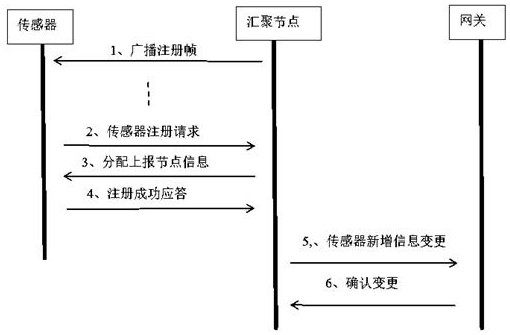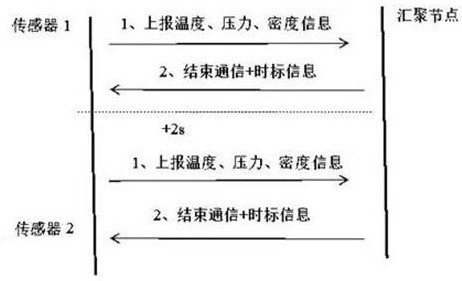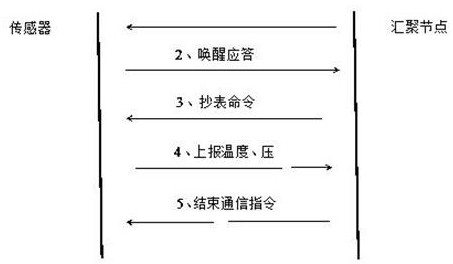Low-power-consumption wireless sensor ad hoc network and communication method
A wireless sensor and communication method technology, applied in wireless communication, network topology, energy consumption reduction, etc., can solve the problems of difficult change of affiliation relationship, cumbersome configuration process, poor networking efficiency, etc., and achieve the effect of increasing the success rate of registration
- Summary
- Abstract
- Description
- Claims
- Application Information
AI Technical Summary
Problems solved by technology
Method used
Image
Examples
Embodiment 1
[0038] like figure 1 As shown, a communication method based on a low-power wireless sensor ad hoc network, the low-power wireless sensor ad hoc network includes a communication link, and the communication link is composed of a gateway, a sink node and at least one sensor , including the following steps:
[0039] S1: The access node and the aggregation node use the same physical channel to communicate in the north direction, and the aggregation node and the terminal use another physical channel to communicate in the south direction; the carrier communication frequency, bandwidth, spreading factor, and transmit power of the physical channel are configured through wireless communication. The access node is divided into a main node and a sub-node, the main node is a gateway, the sub-node is an aggregation node, and the terminal is a sensor, and the sensor can be a plurality of different types of sensors;
[0040] S2: The communication cycle is divided into several frames, and eac...
Embodiment 2
[0057] On the basis of Embodiment 1, after the sensor is networked, the sink node controls whether the sensor needs to be re-networked according to the received information quality of the sensor;
[0058] The sink node reports the registration information of the sensor immediately, and determines whether the sensor needs to be re-networked according to the situation of the sensors under the jurisdiction of each sink node of the gateway and the signal quality between the sink node and the sensor. When the re-registration command of the sink node is executed, the re-sweep registration is automatically initiated, which simplifies the process of re-networking when the communication signal between the sensor and the sink node is poor.
[0059] Specifically, in the communication cycle, when the sensor fails to communicate in the current frame, the sensor performs a competitive reporting in the idle period of the communication cycle.
[0060] Specifically, when the broadcast frame si...
Embodiment 3
[0064] On the basis of Embodiment 2, each sink node reserves network configuration management time. Specifically, during this time period, the sink node can wake up the sensor to perform parameter configuration, time calibration, and data supplementary copying.
[0065] Among them, the specific steps of data supplementary copying are as follows:
[0066] S1: The broadcast frame issued by the sink node wakes up the sensor;
[0067] S2: After the sensor is woken up, it sends a wake-up response to the sink node;
[0068] S3; the sink node sends a meter reading command to the sensor;
[0069] S4: The sensor feeds back the collected data information to the sink node;
[0070] S5: After receiving the data information, the sink node sends an end communication instruction to the sensor.
PUM
 Login to View More
Login to View More Abstract
Description
Claims
Application Information
 Login to View More
Login to View More - Generate Ideas
- Intellectual Property
- Life Sciences
- Materials
- Tech Scout
- Unparalleled Data Quality
- Higher Quality Content
- 60% Fewer Hallucinations
Browse by: Latest US Patents, China's latest patents, Technical Efficacy Thesaurus, Application Domain, Technology Topic, Popular Technical Reports.
© 2025 PatSnap. All rights reserved.Legal|Privacy policy|Modern Slavery Act Transparency Statement|Sitemap|About US| Contact US: help@patsnap.com



